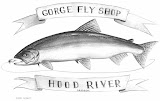 |
| Skagit Compact Generation 2 |
I recently had the chance to talk with Tom Larimer about the New Airflo Skagit Compact G2 Spey Head. He designed this brand-spanking new line, as well as the original Skagit Compact and is the premier steelhead spey line designer in the Northwest.
The original Skagit Compact was just about perfect, so any changes would have to be very meticulously planned and tested, and there is no better man for a meticulous job than Tom. The changes he made are all definite improvements. The major difference between the new G2 and the old Skagit Compact is that the G2 is shortened up to better match today’s rods. Spey rods have shortened up over the past couple of years. Ten years ago, it was rare to see rods under 13’0”, with 14’ rods being about average in length, whereas today’s rods average between 12’6” and 13’6”. The new G2 heads better match the average rods for each grain window.
Another change that Tom made is lengthening the back taper. This helps create longer loops by increasing the length of time/distance it takes to turn over the whole line once it is in the air. It should be easier to keep a cast looking pretty in the air, but it really means longer casts with less energy expended.
Speaking of the back taper… the new two-tone color scheme is pleasing to fish with. It changes at the back taper so you never have to think about which end connects to the running line again, it’s blue.
The important change in the back taper is that it slightly increased in diameter without increasing the relative grains per foot. This is called specific gravity. How much does it float vs. how much does it weigh? By increasing the floatation in the very back end of the line, it will be easier to get the initial break in water tension. This means less initial energy to start the cast, easier mending and better line control.
Tom also had Airflo add their new Super-Dri coating, upgrading from the Polyfuse coating of the past models. Super-Dri is longer lasting with less color fading, better water repulsion, and better floatation, although the specific gravity in the entirety of the line did not change, as in the middle and front part of the line does not float any better than the original Skagit Compact. This is important because if a Skagit Head were to float too high, it would more easily glide through the water and anglers would blow their anchors more often. We need our spey lines to stick to the water just a little bit and this did not change form the previous model.
Besides all of the changes, you probably are wondering how it casts. The 540 grain is the best line that I have cast on my 13’4” 7wt Burkheimer and the Echo Glass 7129-4. I haven’t tried any other sizes yet, but I don’t see it being a problem with any modern spey rod as long as the grain weights are right. It turns over T-14 and big, heavy flies with ease, casts as far and as pretty as I could hope, and it looks good too. Rio, Scientific Anglers and Airflo all make very good Skagit heads that are all wonderful to cast, but I truly think that the Airflo G2 is as good as a Skagit line can be.
We have a few of the Airflo Compact Skagit Generation 1's on SALE!...They're going quick!
The Gorge Fly Shop Team
Speaking of the back taper… the new two-tone color scheme is pleasing to fish with. It changes at the back taper so you never have to think about which end connects to the running line again, it’s blue.
The important change in the back taper is that it slightly increased in diameter without increasing the relative grains per foot. This is called specific gravity. How much does it float vs. how much does it weigh? By increasing the floatation in the very back end of the line, it will be easier to get the initial break in water tension. This means less initial energy to start the cast, easier mending and better line control.
Tom also had Airflo add their new Super-Dri coating, upgrading from the Polyfuse coating of the past models. Super-Dri is longer lasting with less color fading, better water repulsion, and better floatation, although the specific gravity in the entirety of the line did not change, as in the middle and front part of the line does not float any better than the original Skagit Compact. This is important because if a Skagit Head were to float too high, it would more easily glide through the water and anglers would blow their anchors more often. We need our spey lines to stick to the water just a little bit and this did not change form the previous model.
Besides all of the changes, you probably are wondering how it casts. The 540 grain is the best line that I have cast on my 13’4” 7wt Burkheimer and the Echo Glass 7129-4. I haven’t tried any other sizes yet, but I don’t see it being a problem with any modern spey rod as long as the grain weights are right. It turns over T-14 and big, heavy flies with ease, casts as far and as pretty as I could hope, and it looks good too. Rio, Scientific Anglers and Airflo all make very good Skagit heads that are all wonderful to cast, but I truly think that the Airflo G2 is as good as a Skagit line can be.
We have a few of the Airflo Compact Skagit Generation 1's on SALE!...They're going quick!
The Gorge Fly Shop Team




















.jpg)



No comments :
Post a Comment